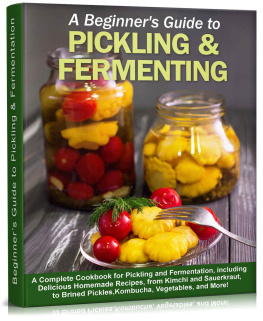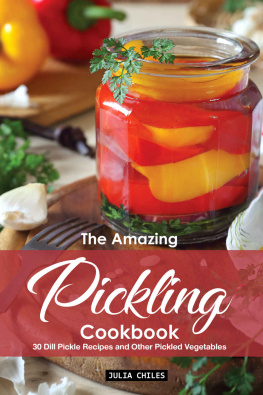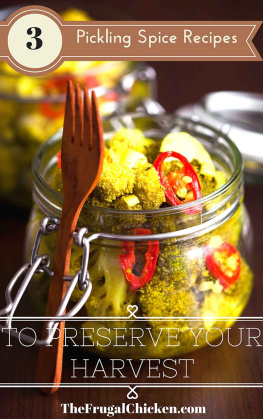HOME PICKLING
Cooks eager to rediscover the lost culinary art of pickling will be well served by this fascinating and informative text, written by the founder of the best-known vinegar and pickling company in the United Kingdom. Beginning with an explanation of the history of pickling, principles and advantages, the book goes on to give detailed instructions on the preservation of artichokes, beans, beetroot, cabbage, shallots, tomatoes, peaches, cherries, a wide variety of chutney s and ketchups, meats and many other foods. Instructions are also given for mixing spices and determining correct levels of acidity and brine.
www.keganpaul.com
THE KEGAN PAUL LIBRARY OF CULINARY ARTS
Editorial Advisor
Peter Hopkins
All About Ices, Jellies and Creams Henry G. Harris and S. P. Borella
Alexander Dumas' Dictionary of Cuisine Alexander Dumas
Dictionary of Cooking
Something New in Sandwiches M. Redington White
Three Hundred and Sixty-Six Menus and Twelve Hundred Recipes Baron Brisse
A Guide to the Greedy by A Greedy Woman Elizabeth Robins Pennell
Book of the Table M. Auguste Kettner
Chinese Cookery Secrets Esther Chan
Food for the Greedy Nancy Shaw
French Household Cooking Frances Keyzer
Good Living Saravan Buren
Home Pickling Henry Sarson
Moorish Recipes John Fourth Marquis of Bute
Mrs. A. B. Marshall\s Cookery Book B. Marshall
Paris Bistro Cookery Alexander Watt
The Country Housewife's Book Lucy H. Yates
The Finer Cooking X. M. Boulestin
The Jam Book May Byron
The Modern Cook Charles Elme Francatelli
The South American Gentleman's Companion Charles H. Baker
What Shall We Have To-Day? X. Marcel Boulestin
A King's Confectioner in the Orient Friedrich Unger
Skuse's Complete Confectioner E. Skuse
The Gentle Art of Cookery Hilda Leyel and Olga Hartley
All About Genoese, Petits Fours, Glaces and Bon Bons H. G. Harris and S. P. Borella
HOME PICKLING
HENRY SARSON
DEDICATION
To all those housewives who have forgotten or never knew how to make pickles like mother used to make; to the enthusiastic diggers of allotments whose surplus onions lie rotting in a corner of the toolshed; to affluent owners of greenhouses whose final crop of tomatoes the fickle English sun failed to ripen, or to anyone else interested in preserving food from waste and in varying its monotony, this book is dedicated.
H. S.
FOREWORD
I AM happy to contribute a foreword to this timely little book, which shows how the fruits of the earth can be preserved by pickling for the winter days ahead.
Who does not remember our mother's store-cupboard and her pride in it ? In days gone by, many of the good things in the cupboard of farm and cottage were pickled. But lately the art of picklingfor it is an arthas fallen into neglect. We shall do well to revive it now. We need to turn to vegetables as a mainstay of our diet in war-time. We shall benefit in health and ease the task of our shipping. Pickling is one method of putting by the surplus of the season for use when supplies are scarce.
Every housewife can help the country by saving food. This little book will prove a useful guide.
15th April 1940
CONTENTS
HOME PICKLING
How I luxuriously thirst for noble pickle.
Martial. Book XIII.
BEFORE express trains and turbine steamers brought the Mediterranean to our back doors or turned the Antipodes into one huge larder, pickling was of supreme importance to every household. Winters were long and grim, fresh vegetables practically unprocurable, whilst for months on end fruit was unknown to masses of the people.
Winter diet largely consisted of pickled food in various forms : salted and smoked meats such as beef, pork, bacon and hams ; pickled and salted fish, especially herrings and a wide range of what we understand to-day by pickles ; vegetables and fruits preserved in vinegar and spices.
The stillroom one constantly finds reference to in old cookery books was the household factory and stores. Here the Industrious housewife made her preserves, brewed the beer, cider, perry or mead, and put down her pickles. It was her ability and pride to guard against the possibility of future want, if not actual famine, by having always on hand ample supplies of preserved and pickled foods, and very well she seems to have done it judging by the recipes and menus handed down to us.
As the population of the country increased and the towns grew into cities and the villages into (owns, providing food for the people became an industry and the household ceased to be a self-contained unit. The butcher, baker and candlestick-maker became people of local and finally national importance, with a corresponding decrease in strictly household-produced foods. This tendency was very marked with what is roughly called the industrial revolution. Cheap and efficient transport as developed by the railways made fresh fish available everywhere, and fish pickling was the first to die a natural death. Yet pickled fish were eaten in every household barely a hundred years ago, every little sea-coast village possessed some sort of fish-pickler, and even such remote districts as the Cotswolds pickled and cured salmon and trout. To-day the only relic we have in our diet is a Bismarck herring used as an hors d'oeuvres and an occasional soused herring or mackerel. Except for epicures the others are unobtainable !
The next great blow at home pickling was the discovery and development of canning, and this was quickly followed by its ally in mass food production, refrigeration. Both of these have been of immense value to the diet of the people, but like all good things they can be overdone. Mass production means monotony, and it is so simple when the unexpected guest arrives to pop round the corner and buy something tasty in a tin. Yet your great-grandmother would not have had to pop, she would have had that something tasty in her stillroom or larder and would have been saved at least the agony of a gashed thumb from a tin-opener that won't work.
To-day there are definite signs of revolt against this state of affairs, noticeably so in the greatly increased jam-making at home (for jams are only fresh fruit pickled in sugar), whilst a glance at the women's magazines and women's pages in the newspapers show that a new interest is being taken in food and its variation.
Yet the very blessings that science has brought us through transport, canning and refrigeration have made variation more difficult for the average housewife. Our chief meats are still beef, mutton, pork and bacon, and indeed in flesh foods there has been a decrease in variety. Venison is practically unheard of to-day, whilst game and wild-fowl are strictly preserved and available in limited quantities only.
Luckily this does not apply to vegetables and fruits. Our ancestors had nothing approaching the supply or variety we enjoy, but what they had they used to good purposes.









